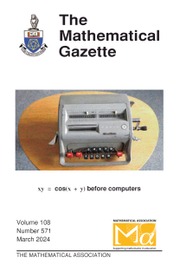No CrossRef data available.
Article contents
An Introduction to Exponentials for Technical Students
Published online by Cambridge University Press: 03 November 2016
Extract
The method of introducing e so common in text-books based upon an algebraic proof of the exponential series may be satisfactory for mathematical students, but it does not meet the needs of technical students (especially evening students), for it is impossible, if even desirable, to treat the matter along these lines in a manner at once brief, exact, and comprehensible. Moreover, it suffers from the great disadvantage that the property of e, which is of prime importance in technical applications, namely that ex is the function appropriate to the expression of the law of growth or decay so common in these—in other words, that ex is the solution of the differential equation dy/dx=y —appears as an afterthought, and not as the fundamentally important property, the raison d’être of the inclusion of e in the course and in the engineering formulae. The method outlined below, which has been tried for some few sessions, aims at presenting the differential equation as arising in the attempt to solve a concrete practical problem, and the discovery and identification of two solutions—one a series, the other in terms of indices. By obtaining the series first some idea of the use of non-terminating series, and appreciation of convergence, are gained. To simplify the numerical calculations, the index solution is then found. Here e appears as a limit, and to obtain its numerical value recourse must be had to the series.
Information
- Type
- Research Article
- Information
- Copyright
- Copyright © Mathematical Association 1926

